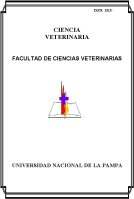Medición de cortisol en leche como indicador de bienestar animal, resultados preliminares
Abstract
A trial was done to assess dairy cow welfare measuring milk cortisol concentration, which has a high and direct correlation with plasma cortisol. A group of cows in lactation were selected randomly from an Argentinean Holland herd (n = 349 dairy cows), and were put on a stress treatment (ST group n= 6) by a magneto phonic recording of dogs barking. Treatment was done during two hours before milking, then 1) foremilk samples were taken from each cow forming a milk pool from each mammary quartile, and 2) each cow was completely milked and a milk pool was taken. Another group of cows handled routinely were selected randomly as a control group (CG n = 14), 3) foremilk samples were taken idem (1) and 4) a bulk milk tank sample was taken at the end of the milking. Milk samples were frozen and sent to laboratory. Cortisol was measured by electroquimioluminescente technique.1) ST Foremilk samples average: 3.34 +- 1.90 ng (SD) (a) ml/milk. 2) ST pool milk : 6,55 ng/ml. 3) CG Foremilk samples average: 0.96 +- 0.41 ng (SD) (b) ml/milk. 4) CG Bulk milk tank: 0,98 ng/ml. Difference between ST (a) and CG (b) were positively significant (p 0.01) test ANOVA. Conclusion: 1) ST shows an important increase of cortisol regards CG, being this a good indicator for measuring stress situation and therefore dairy cow welfare, 2) CG bulk milk tank in this herd was 0,98 ng ml/milk. Cortisol in milk was high in comparison with other determinations: 0.3 to 0.5 ng/ml (Fox, L. 1981; Termeulem, S. 1981; Shutt, D. 1985; y Dobson, H. 1986), but similar to Verkerk, G. 1998) 1.2 ng/ml. Trials will be to find bulk milk tank cortisol concentration and its correlation with milk composition, SCC and TBC. Objective will be to find which the real level of milk cortisol is in a healthy dairy herd.Downloads
Downloads
Published
How to Cite
Issue
Section
License
Al momento de enviar sus contribuciones, los colaboradores deberán declarar , de manera fehaciente, que poseen el permiso del archivo o repositorio donde se obtuvieron los documentos que se anexan al trabajo, cualquiera sea su formato (manuscritos inéditos, imágenes, archivos audiovisuales, etc.), permiso que los autoriza a publicarlos y reproducirlos, liberando a la revista y sus editores de toda responsabilidad o reclamo de terceros , los autores deben adherir a la licencia Creative Commons denominada “Atribución - No Comercial CC BY-NC-SA”, mediante la cual el autor permite copiar, reproducir, distribuir, comunicar públicamente la obra y generar obras derivadas, siempre y cuando se cite y reconozca al autor original. No se permite, sin embargo, utilizar la obra con fines comerciales.




.jpg)

4.png)


7.png)



